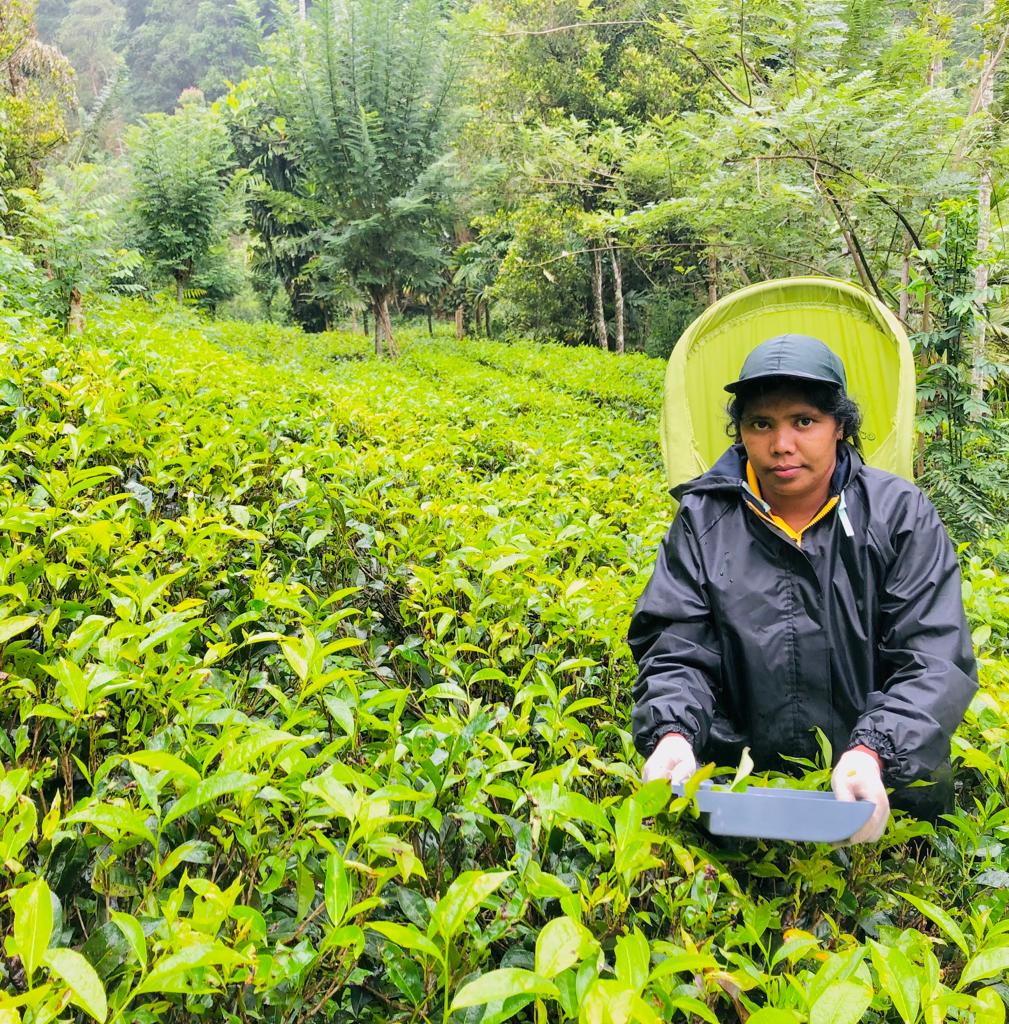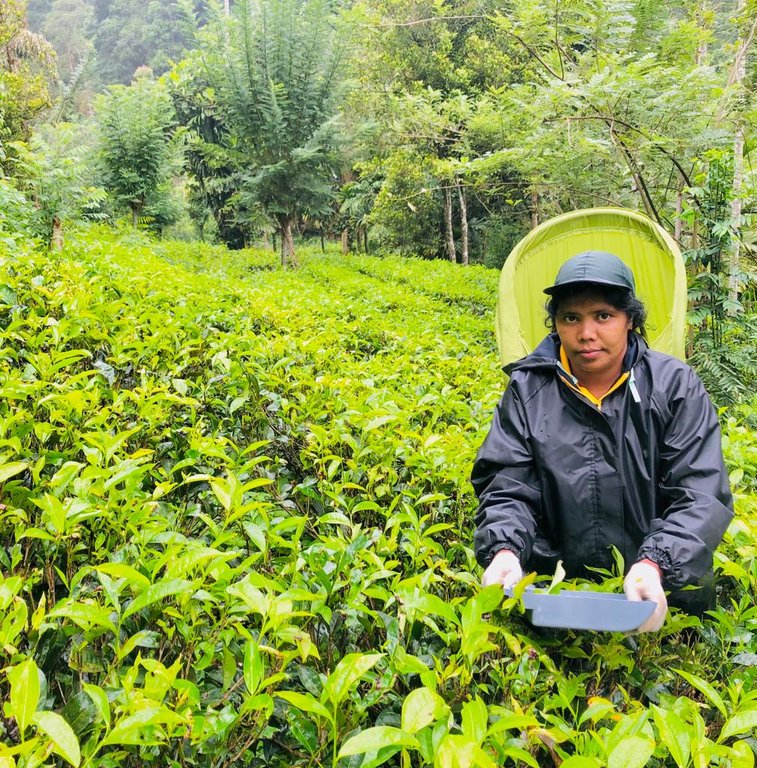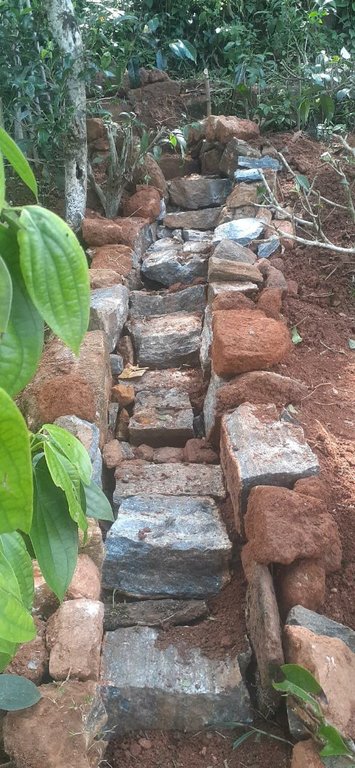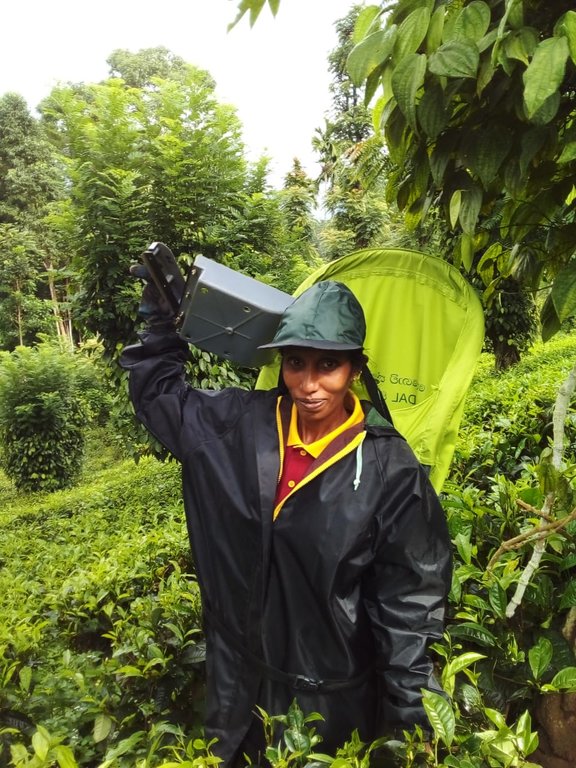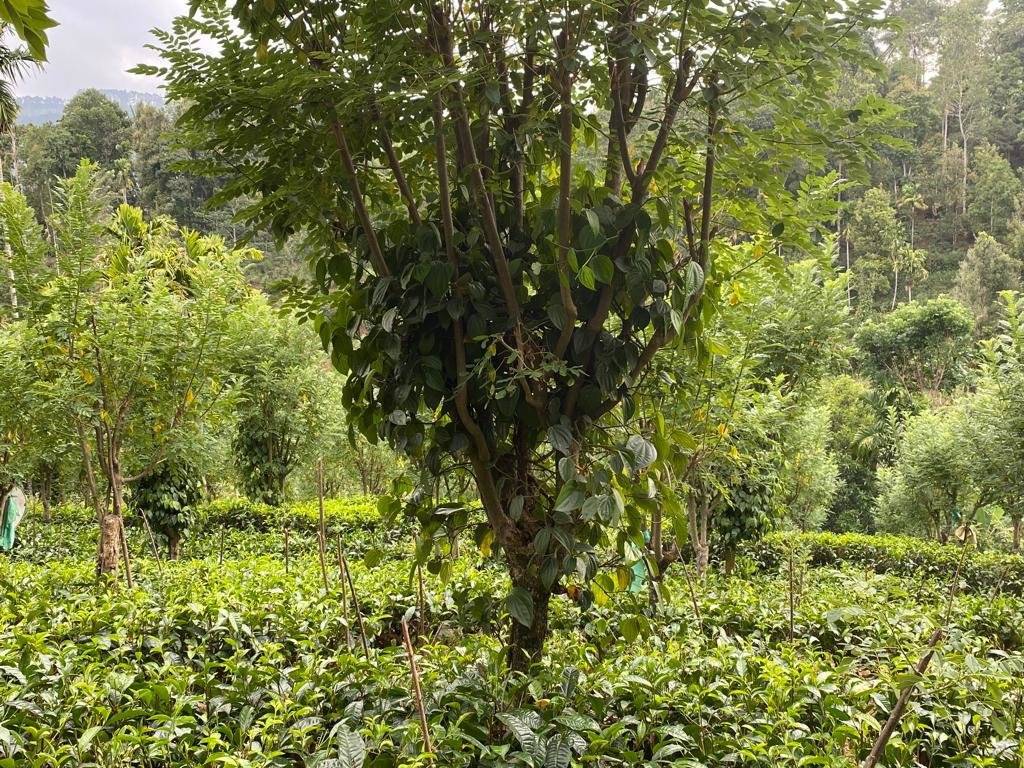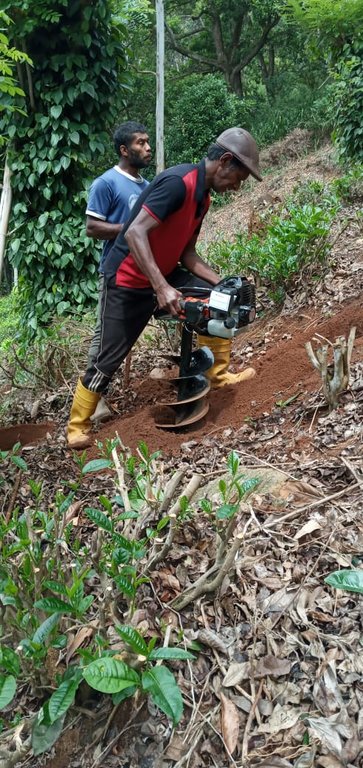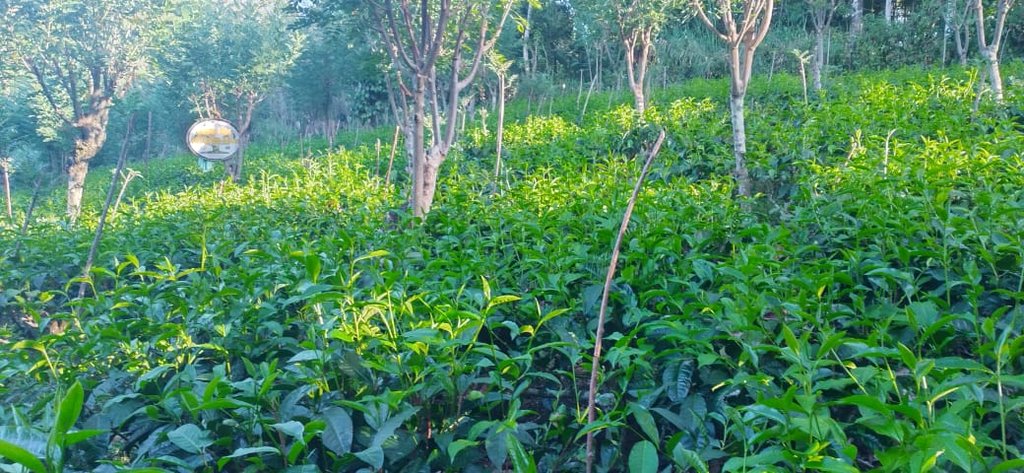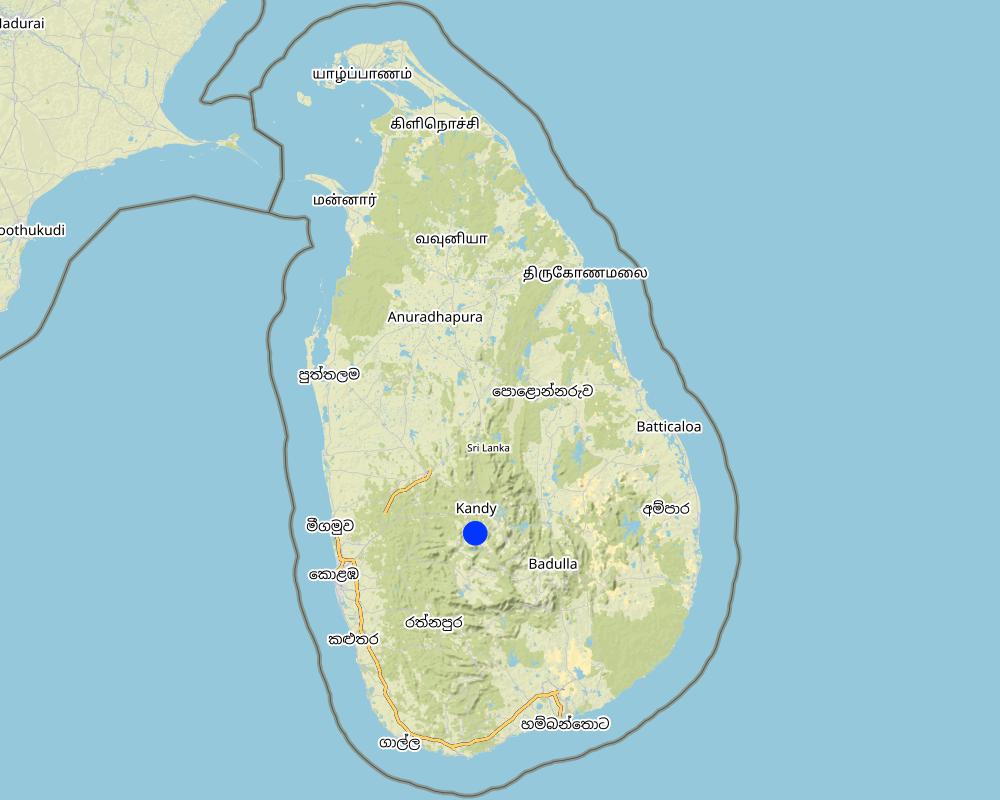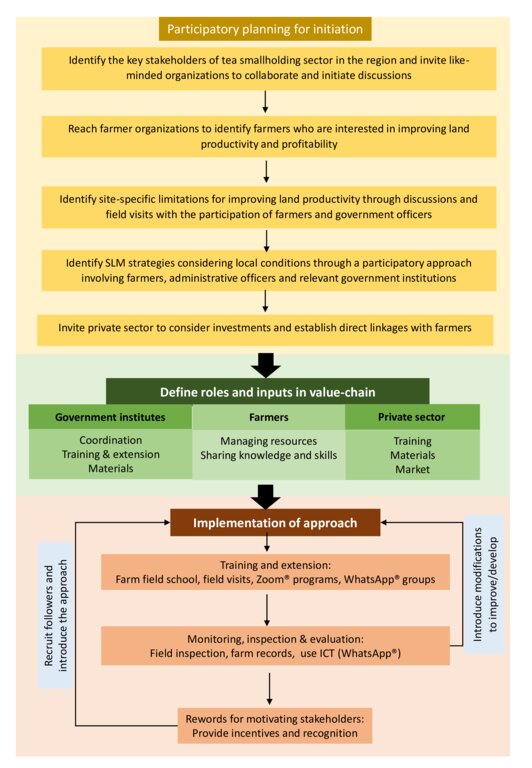Inter-sectoral collaboration for sustainable land management in tea smallholdings [ศรีลังกา]
- ผู้สร้างสรรค์:
- การอัพเดท:
- ผู้รวบรวม: Head Soil Science
- ผู้เรียบเรียง: –
- ผู้ตรวจสอบ: William Critchley, Rima Mekdaschi Studer
Inter-sectoral collaboration for sustainable land management in tea smallholdings
approaches_6182 - ศรีลังกา
ดูส่วนย่อย
ขยายทั้งหมด ย่อทั้งหมด1. ข้อมูลทั่วไป
1.2 รายละเอียดที่ติดต่อได้ของผู้รวบรวมและองค์กรที่เกี่ยวข้องในการประเมินและการจัดเตรียมทำเอกสารของแนวทาง
co-compiler:
co-compiler:
Agrarian Research and Production Assistant:
Iroshini Senevirathna
+94778278582
iroshinisenavirathna@gmail.com
Department of Agrarian Development
Agrarian Research and Production Assistant Office, "Nila Sewana", Pambadeniya
ศรีลังกา
ผู้ใช้ที่ดิน:
Pushpa Ranjani
+94767817221
“Sithamu Ranliya” farmer's organization
Pambadeniya, Panvilathanna
ศรีลังกา
ชื่อของโครงการซึ่งอำนวยความสะดวกในการทำเอกสารหรือการประเมินแนวทาง (ถ้าเกี่ยวข้อง)
Rehabilitation of Degraded Agricultural Lands in Kandy, Badulla and Nuwara Eliya Districts in the Central Highlands of Sri Lankaชื่อของโครงการซึ่งอำนวยความสะดวกในการทำเอกสารหรือการประเมินแนวทาง (ถ้าเกี่ยวข้อง)
Faculty of Agriculture, University of Peradeniya, Sri Lanka (AGRI.PDN) - ศรีลังกา1.3 เงื่อนไขที่เกี่ยวข้องกับการใช้ข้อมูลที่ได้บันทึกไว้ผ่านทาง WOCAT
วันที่เก็บรวบรวมข้อมูล (ภาคสนาม):
25/02/2022
ผู้รวบรวมและวิทยากรหลักยอมรับเงื่อนไขเกี่ยวกับการใช้ข้อมูลที่ถูกบันทึกผ่านทาง WOCAT:
ใช่
2. คำอธิบายของแนวทาง SLM
2.1 การอธิบายแบบสั้น ๆ ของแนวทาง
Participatory land restoration with the collective efforts of different stakeholders can assure sustainable use of land-resources. This approach promoted sustainable land management technologies such as agroforestry, soil conservation, and soil fertility enhancement practices through inter-sectoral collaboration, including the use of digital tools and Farmer Field Schools (FFS) to provide training and resources, disseminate knowledge, improve market-orientation of farmers, and monitor and evaluate the progress of activities for rehabilitating and increasing the productivity of degraded tea smallholdings in the Central Highlands of Sri Lanka.
2.2 การอธิบายอย่างละเอียดของแนวทาง
การอธิบายอย่างละเอียดของแนวทาง:
Due to unsustainable land management practices the monthly average green-leaf yield of tea smallholdings in Maligamale watershed in the Central Highlands of Sri Lanka is as low as 1000 kg/hectare, whereas the potential is 2400 kg/hectare. Soil erosion, soil fertility decline, low plant density, and poor shade management are among the main reasons for low productivity. This causes reduced household incomes and farmers’ ability to invest in sustainable land management (SLM) practices. Inefficiencies in top-down extension methodology, lack of awareness and training on tea cultivation techniques, poor business practices, lack of access to services and poor perceptions about SLM have reduced profit margins of tea smallholdings. Hence, the aim/ objectives of the approach are to increase the land productivity in tea smallholdings and increase farmer’s incomes and gain environmental benefits through proper implementation of SLM practices. To address this, the Rehabilitation of Degraded Agricultural Land Project (RDALP) introduced a participatory approach together with Tea Smallholdings Development Authority (TSHDA), Department of Agrarian Development and other relevant government institutions, the private sector and farming community. The approach considered methods for strengthening linkages between stakeholder groups, providing training and resources for SLM practices, enhancing market orientation, using ICT for knowledge sharing, monitoring and evaluation, improving perceptions of farming community on agriculture and enhancing food-security of the households.
Firstly, tea smallholders who volunteered to learn about SLM were linked with the experts to collectively develop a participatory land restoration proposal. Site specific limitations for productivity improvement, recommendations, roles of different stakeholders, and training and material needs were identified in the proposal. The existing institutional setup was used for coordination of activities. The experts from government institutes provided training on SLM through farmer field schools, field demonstrations and ICT tools. More specifically, farmers were educated on soil conservation and soil fertility management practices: these included producing organic fertilizers using locally available resources, building live fences with green-manure crops and edible crops, intercropping using export agriculture crops, in-filling, selective weeding, developing and maintaining nurseries, using machinery for cutting pits and harvesting, using safety measures during field operations, and shade tree management. In addition, farmers have been encouraged to share good-practices, keep records and practice soil test-based decision making for nutrient management. Farmers and officers effectively used WhatsApp®, Zoom® and Facebook® for knowledge sharing and for monitoring and evaluating progress. Dissemination of knowledge using ICT and performance-based rewarding helped to recruit more farmers as followers. The TSHDA supported with extension service and regular monitoring of progress. With the support of government institutes, farmers were linked with private sector companies to promote market orientation. Export agriculture crops such as peppers, vanilla, areca nut and cloves were successfully incorporated into tea smallholding landscape, allowing farmers to earn an extra income. The partners from the private sector provided planting materials and extension services to transfer necessary knowledge and skills to the farmers. Machinery was provided to farmer organizations for the members to share.
Improving profitability of farming, improving hygiene and safety of farmers, and reducing time spent on agronomic practices have uplifted the living-status of famers and increased their willingness to invest in SLM. These characters could attract youth to the sector.
2.3 รูปภาพของแนวทาง
2.4 วีดีโอของแนวทาง
ความคิดเห็น อธิบายสั้นๆ:
https://www.youtube.com/watch?v=SU3--fHKY1k
Application of ICT for knowledge dissemination and agricultural extension service
วันที่:
20/07/2021
สถานที่:
Pambadeniya, Panvilathanna
2.5 ประเทศ ภูมิภาค หรือสถานที่ตั้งที่ได้นำแนวทางไปใช้
ประเทศ:
ศรีลังกา
ภูมิภาค/รัฐ/จังหวัด: :
Kandy District- Central Province
ข้อมูลเฉพาะเพิ่มเติมของสถานที่ตั้ง:
Pambadeniya village
ความคิดเห็น:
The region is in the Maligamale watershed in the Central Highlands of Sri Lanka.
Map
×2.6 วันที่เริ่มต้นและสิ้นสุดของแนวทาง
ระบุปีที่เริ่ม:
2017
ความคิดเห็น:
Approach is still carrying out by land user
2.7 ประเภทของแนวทาง
- ใช้โครงงานหรือแผนงานเป็นฐาน
2.8 เป้าหมายหรือวัตถุประสงค์หลักของแนวทาง
The aims/ objectives of the approach are to increase the land productivity in tea smallholdings and increase farmers' income and environmental benefits through proper implementation of SLM practices.
2.9 เงื่อนไขที่เอื้ออำนวยหรือเป็นอุปสรรคต่อการนำเทคโนโลยีภายใต้แนวทางนี้ไปปฏิบัติใช้
บรรทัดฐานและค่านิยมทางสังคม วัฒนธรรม ศาสนา
- เอื้ออำนวย
Increased livelihood requirements and access to education, market and health services
- เป็นอุปสรรค
Migration of youth and males to cities
การมีไว้ให้หรือการเข้าถึงแหล่งการเงินและบริการ
- เอื้ออำนวย
Providing funds/ subsidies has increased the access to financial resources (subsidy schemes of TSHDA, Loan facilities of tea factories)
- เป็นอุปสรรค
Access of farmers to resources is limited by their financial situation as well as geographic location.
การจัดตั้งระดับองค์กร
- เอื้ออำนวย
An institutional set-up for facilitating the approach already exists and all technical support is providing by institutes
- เป็นอุปสรรค
Mandate of some institutions are not clearly defined. Decision making is very often a top-down approach
การร่วมมือหรือการทำงานประสานกันของผู้ลงมือปฏิบัติ
- เอื้ออำนวย
Institutes have some level of collaboration
- เป็นอุปสรรค
There is lack of motivation to initiate collaboration and the level of collaboration depends on the commitments of the officers. Institutional mechanisms do not encourage the collaborations
กรอบแนวทางในการดำเนินการด้านกฎหมาย (การถือครองที่ดิน สิทธิในการใช้ที่ดินและน้ำ)
- เอื้ออำนวย
Some land users own their land
- เป็นอุปสรรค
Some lands used by farmers are owned by the state and there are issues on land rights. Water availability is problematic to farmers as the crop is maintained as a rainfed crop. In the region, drinking water is supplied in ten days interval during dry-months
นโยบาย
- เอื้ออำนวย
National soil conservation act
- เป็นอุปสรรค
Implementation of policies to action is very low
การกำกับดูแลที่ดิน (การตัดสินใจ การนำเอาไปปฏิบัติใช้ และการบังคับใช้)
- เอื้ออำนวย
Farmers participated in the decision-making process related to land management. Land is maintained based on the advice given under the approach. Most of the technologies introduced were not gender biased and therefore, involvement of women in management practices increased
- เป็นอุปสรรค
Dependence on males is high for agronomic practices in tea-cultivation
ความรู้เกี่ยวกับ SLM การเข้าถึงการสนับสนุนด้านเทคนิค
- เอื้ออำนวย
Farmers were guided through farmer training programs, practical sessions, farmer field schools, Zoom® meetings, sharing knowledge through WhatsApp® groups and Facebook.
- เป็นอุปสรรค
Shortage of tea extension officers
ตลาด (จัดซื้อปัจจัยนำเข้า ขายผลิตภัณฑ์) และราคา
- เอื้ออำนวย
Private companies come to fields to purchase products and they provide extension support and material inputs to some extent to the farmers who have established links with them
- เป็นอุปสรรค
Market orientation of farmers is low and their ability to negotiate prices is poor due to various factors
ปริมาณงานที่ทำได้ กำลังคนที่มีให้
- เอื้ออำนวย
Labour resources are available. Introduction of machinery created shared responsibilities and reduced labour demand while creating an income source for the farmer organizations. Decent working environment with safety kits and machineries will encourage the labour force to remain in the sector
- เป็นอุปสรรค
Labour force continuously moving away from the industry
3. การมีส่วนร่วมและบทบาทของผู้มีส่วนได้ส่วนเสียที่เกี่ยวข้อง
3.1 ผู้มีส่วนได้ส่วนเสียที่เกี่ยวข้องในแนวทางนี้และบทบาท
- ผู้ใช้ที่ดินระดับท้องถิ่นหรือชุมชนระดับท้องถิ่น
Men and women farmers are involved in tea cultivation
They involved in practicing SLM technologies as the technologies were not gender biased. But the operation of mechanical weeder and auger for infilling are mainly done by male farmers.
- องค์กรที่ขึ้นอยู่กับชุมชน
Farmer organizations
Support coordination of activities with farmers
Support Farmer Field Schools
Maintain common equipment and rent for members and non-members to support SLM practices
- ผู้เชี่ยวชาญ SLM หรือที่ปรึกษาการเกษตร
Tea Smallholding Development Authority, Department of Agrarian Development, Department of Export Agriculture, Department of Agriculture
Provide tea plants for infilling, promote inter-cropping and provide technical guidance to farmers
Serve as resource-persons in Farmer Field Schools and in WhatsApp® groups
- นักวิจัย
University of Uva Wellassa, Sri Lanka
Study the effectiveness of knowledge dissemination approach and effectiveness of some SLM technologies
- ภาคเอกชน
Several private sector companies are involved (Bio Food (Pvt) Ltd, Adamjee Lukmanjee (Pvt) Ltd)
Buying products, providing planting materials and continuing extension services to transfer necessary knowledge and skills to the farmers who are linked with them
- รัฐบาลระดับท้องถิ่น
Local government institutes are involved in the process (Tea Smallholdings Development Authority (TSHDA), Department of Agrarian Development, Department of Agriculture, Department of Export Agriculture, Divisional Secretariat office- Doluwa
Capacity building, advisory services on fertilizer usage, land management, crop selection etc.
- รัฐบาลแห่งชาติ (ผู้วางแผน ผู้ทำการตัดสินใจ)
Ministry of Environment
Helps to raise awareness among private and government sector stakeholders and within communities about SLM approaches and technologies,
Project coordination and partial financial support
- องค์การระหว่างประเทศ
Food and Agriculture Organization of the United Nations
Project coordination, partial financial support and capacity building
ถ้ามีผู้มีส่วนได้ส่วนเสียหลายคนที่เกี่ยวข้องให้ระบุหน่วยงานตัวแทน:
Tea Smallholdings Development Authority (TSHDA)
3.2 การเกี่ยวข้องของผู้ใช้ที่ดินระดับท้องถิ่นหรือชุมชนระดับท้องถิ่นในช่วงต่างๆของแนวทาง
| ความเกี่ยวข้องของผู้ใช้ที่ดินระดับท้องถิ่นหรือชุมชนระดับท้องถิ่น | ระบุผู้ที่มีส่วนเกี่ยวข้องและอธิบายกิจกรรม | |
|---|---|---|
| การริเริ่มหรือการจูงใจ | ปฏิสัมพันธ์ | Government agencies, representatives from farmer organizations, RDALP team. Discussions to develop participatory land use plans for a region and identify the sectors to be developed |
| การวางแผน | ปฏิสัมพันธ์ | Government agencies, representatives from farmer organizations, RDALP team Discussions, site visits and field programs to identify factors limiting land productivity and implementation of SLM practices Identify strategies to address these limitations Identify how the private sector can contribute and invite them to invest |
| การดำเนินการ | ปฏิสัมพันธ์ | Government agencies, leaders of farmer organizations, farmers, RDALP team, private sector companies Training and dissemination of knowledge through demonstrations, farmer training programs, farmer field schools Progress monitoring and evaluation Provide advisory services to farmers as needed Conduct performance-based rewarding to motivate the practitioners and to recruit followers |
| การติดตามตรวจสอบหรือการประเมินผล | ปฏิสัมพันธ์ | TSHDA, RDALP team, farmers, private sector companies make observations in fields, guiding land users, exchange photos through whatsapp® Some private sector companies also involve in monitoring and field evaluating process (Adamjee Lukmanjee (Pvt) Ltd) |
3.3 แผนผังแสดงขั้นตอนการทำงาน (ถ้ามี)
คำอธิบาย:
Before implementing the approach the level of productivity of tea lands that belong to the farmers who participated in the project were in class ‘C’ and below. In this scale of productivity lands were classified from A to D where A is the best and D is the worst. After implementation of the approach most of the fields upgraded to ‘A’ and ‘B’ performance levels. An interview conducted with a farmer revealed that the average green-leaf tea yield before and after participating in the approach were 1000 kg/ha/month and 2400 kg/ha/month, respectively.
ผู้เขียน:
Warshi S. Dandeniya
3.4 การตัดสินใจเลือกใช้เทคโนโลยี SLM
ระบุผู้ที่ทำการตัดสินใจเลือกเทคโนโลยีมากกว่าหนึ่งวิธีไปปฏิบัติใช้:
- ผู้ลงมือปฏิบัติที่เกี่ยวข้องทั้งหมดในฐานะที่เป็นส่วนรวมของแนวทาง
ระบุว่าการตัดสินใจตั้งอยู่บนพื้นฐานของ:
- การประเมินความรู้ SLM ที่ได้ทำการบันทึกไว้เป็นอย่างดี (การใช้ข้อมูลในการตัดสินใจ)
- สิ่งที่ค้นพบจากงานวิจัย
- ประสบการณ์และความคิดเห็นส่วนตัว (ไม่ได้ลงบันทึกไว้)
4. การสนับสนุนด้านเทคนิค การสร้างขีดความสามารถ และการจัดการด้านความรู้
4.1 การสร้างขีดความสามารถ / การอบรม
ได้มีการจัดอบรมให้แก่ผู้ใช้ที่ดินหรือผู้มีส่วนได้ส่วนเสียคนอื่น ๆ หรือไม่:
ใช่
ให้ระบุว่าใครเป็นผู้ได้รับการอบรม:
- ผู้ใช้ที่ดิน
- เจ้าหน้าที่ภาคสนาม / ที่ปรึกษา
ถ้าเกี่ยวข้อง ให้ระบุ เพศ อายุ สถานภาพ ชาติพันธุ์ เป็นต้น:
Training was provided for both men and women; age between 20-70 years old
รูปแบบการอบรม:
- เกษตรกรกับเกษตรกร
- ใช้พื้นที่ทำการสาธิต
- จัดการประชุมสู่สาธารณชน
- จัดคอร์ส
รูปแบบการอบรม:
- Zoom discussions, Farm Field Schools
หัวข้อที่พูด:
Soil conservation practices, intercropping in tea lands, organic fertilizer preparation (compost tea, vermi- compost), burying of pruned plant parts, infilling, documentation, improving tea buds quality and quantity, handling of machines for cutting pits and tea plucking
ความคิดเห็น:
Farmer trainings are much important to spread easy agronomic practices and scientific knowledge to farmers
4.2 การบริการให้คำแนะนำ
ผู้ใช้ที่ดินมีการเข้าถึงการรับบริการให้คำปรึกษาหรือไม่:
ใช่
ระบุว่ามีบริการให้คำปรึกษาหรือไม่:
- ไปเยี่ยมชมสถานที่
การอธิบาย/แสดงความคิดเห็น:
Demonstration, advisory service was carried out through: government extension system, agricultural instructors and some private sector companies such as Adamjee Lukmanjee (Pvt) Ltd company which is giving support to enhance vanilla cultivation as an intercrop
4.3 การเสริมความแข็งแกร่งให้กับสถาบัน (การพัฒนาองค์กร)
สถาบันได้รับการจัดตั้งขึ้นมาหรือเสริมความแข็งแกร่งโดยแนวทางนี้หรือไม่:
- ใช่ ปานกลาง
ระบุระดับของสถาบันที่ได้รับการเสริมความแข็งแกร่งหรือจัดตั้งขึ้นมา:
- ท้องถิ่น
ระบุประเภทของการให้ความช่วยเหลือสนับสนุน:
- การสร้างขีดความสามารถ / การอบรม
- อุปกรณ์
- providing safety kits and tea plants for infilling
ให้รายละเอียดเพิ่มเติม :
Organizing and conducting training programs, providing machineries for tea plucking and cutting pits, distribute safety kits among land users
4.4 การติดตามตรวจสอบและประเมินผล
การติดตามตรวจสอบและประเมินผลเป็นส่วนหนึ่งของแนวทางหรือไม่:
ใช่
ถ้าตอบว่าใช่ แสดงว่าการจัดเตรียมเอกสารนี้มุ่งหวังที่จะเอาไปใช้สำหรับการติดตามตรวจสอบและประเมินผลใช่หรือไม่:
ไม่ใช่
4.5 การวิจัย
การวิจัยเป็นส่วนหนึ่งของแนวทางหรือไม่:
ใช่
ระบุหัวข้อเรื่อง:
- เทคโนโลยี
5. การสนับสนุนด้านการเงินและวัสดุอุปกรณ์
5.1 ระบุงบประมาณประจำปีสำหรับแนวทาง SLM นี้
ถ้าหากว่างบประมาณประจำปีไม่เป็นที่ทราบแน่นอน ให้ระบุช่วงลงไป:
- 10,000-100,000
5.2 การสนับสนุนด้านการเงิน / วัสดุอุปกรณ์ให้แก่ผู้ใช้ที่ดิน
ผู้ใช้ที่ดินได้รับการสนับสนุนด้านการเงิน / วัสดุอุปกรณ์ไปปฏิบัติใช้เทคโนโลยีหรือไม่:
ใช่
ถ้าใช่ ให้ระบุประเภทของการสนับสนุน เงื่อนไขและผู้จัดหามาให้:
Provide machinery for cutting pits and plucking, safety kits and tea plants for infilling as material support, provide financial support for soil testing, to add liming material for correcting soil pH for those who performed soil testing
The material and financial support was provided by RDALP team with contributions from TSHDA and private sector based on performance evaluation
5.3 เงินสนับสนุนสำหรับปัจจัยนำเข้า (รวมถึงแรงงาน)
- อุปกรณ์
| ระบุปัจจัยนำเข้าที่ได้รับการสนับสนุน | เห็นด้วยระดับไหน | ระบุเงินสนับสนุน |
|---|---|---|
| เครื่องจักร | ได้รับการช่วยเหลือทางการเงินแบบเต็ม | Tea plucking machines, grass cutting machines and machine for cutting pits in tea lands |
| เครื่องมือ | ได้รับการช่วยเหลือทางการเงินแบบเต็ม | Tea buds collecting buckets |
- การเกษตร
| ระบุปัจจัยนำเข้าที่ได้รับการสนับสนุน | เห็นด้วยระดับไหน | ระบุเงินสนับสนุน |
|---|---|---|
| Planting materials, liming materials | ได้รับการช่วยเหลือทางการเงินแบบเต็ม | Tea plants for infilling, liming materials to correct soil pH, soil testing service |
- อื่น ๆ
| อื่นๆ (ระบุ) | เห็นด้วยระดับไหน | ระบุเงินสนับสนุน |
|---|---|---|
| Safety kits | ได้รับการช่วยเหลือทางการเงินแบบเต็ม |
ถ้าแรงงานโดยผู้ใช้ที่ดินเป็นปัจจัยนำเข้าที่มีอยู่มากมาย ระบุด้วยว่าเนื่องจาก:
- สมัครใจ
ความคิดเห็น:
Most of the time family members are engaged with field activities and hire labour for tea plucking
5.4 เครดิต
มีการจัดหาเครดิตมาให้ภายใต้แนวทาง SLM หรือไม่:
ไม่ใช่
5.5 แรงจูงใจหรือเครื่องมืออื่น ๆ
แรงจูงใจหรือเครื่องมืออื่น ๆ ได้ถูกนำไปใช้ส่งเสริมการใช้เทคโนโลยี SLM หรือไม่:
ใช่
6. การวิเคราะห์ผลกระทบและการสรุป
6.1 ผลกระทบของแนวทาง
ทำให้ผู้ใช้ที่ดินระดับท้องถิ่นมีอำนาจขึ้น ปรับปรุงการเข้าร่วมของผู้มีส่วนได้ส่วนเสียให้ดีขึ้นหรือไม่:
- ไม่ใช่
- ใช่ เล็กน้อย
- ใช่ ปานกลาง
- ใช่ อย่างมาก
Application of organic fertilizers such as compost tea, vermi-compost enhance the market value and some farmers ventured into organic tea production
ช่วยในการตัดสินใจโดยดูจากหลักฐาน ได้หรือไม่:
- ไม่ใช่
- ใช่ เล็กน้อย
- ใช่ ปานกลาง
- ใช่ อย่างมาก
Participatory approach in all stages of the project and farmer field schools encouraged the farmers and officers for evidence-based decision making. This also helped to recruit followers for the approach.
ช่วยให้ผู้ใช้ที่ดินนำเอาเทคโนโลยี SLMไปใช้และบำรุงรักษาสภาพไว้ได้หรือไม่:
- ไม่ใช่
- ใช่ เล็กน้อย
- ใช่ ปานกลาง
- ใช่ อย่างมาก
Approach helps to maintain better environment within the community as it introduced practices that improved safety and hygiene of the farmers while being more efficient. Farmers have been maintaining the SLM technologies
ปรับปรุงความร่วมมือกันและการดำเนิน งานของ SLM ได้อย่างมีประสิทธิผลหรือไม่:
- ไม่ใช่
- ใช่ เล็กน้อย
- ใช่ ปานกลาง
- ใช่ อย่างมาก
Approach used existing institutional set-up and farmer organizations to coordinate the activities. Therefore, it was cost effective and helped to strengthen the collaborations between stakeholders
ระดมกำลังหรือปรับปรุงการเข้าถึงแหล่ง เงินทุนสำหรับการดำเนินการ SLM หรือไม่:
- ไม่ใช่
- ใช่ เล็กน้อย
- ใช่ ปานกลาง
- ใช่ อย่างมาก
Introducing private sector collaborations and improving market orientation of farmers helped to attract financial support to maintain sustainability of the approach
ปรับปรุงความรู้และความสามารถของผู้ใช้ที่ดินในการดำเนินการ SLM หรือไม่:
- ไม่ใช่
- ใช่ เล็กน้อย
- ใช่ ปานกลาง
- ใช่ อย่างมาก
Approach improved the knowledge and capacity of practitioners. Although only about 25 farmers attended farmer field school the number of farmers who joined WhatsApp group is high as 70. Farmers are sharing knowledge and experiences and were able to improve land productivity through the approach
ปรับปรุงความรู้และความสามารถของผู้มีส่วนได้ส่วนเสียคนอื่น ๆ ให้ดีขึ้นหรือไม่:
- ไม่ใช่
- ใช่ เล็กน้อย
- ใช่ ปานกลาง
- ใช่ อย่างมาก
The knowledge and capacities of other stakeholders were improved similarly. Several officers were trained on SLM practices and technologies, use of ICT for extension, etc
ทำให้ผู้ใช้ที่ดินระดับท้องถิ่นมีอำนาจขึ้น ปรับปรุงการเข้าร่วมของผู้มีส่วนได้ส่วนเสียให้ดีขึ้นหรือไม่:
- ไม่ใช่
- ใช่ เล็กน้อย
- ใช่ ปานกลาง
- ใช่ อย่างมาก
Approach helps to strengthen the collaboration between institutes and stakeholders
ช่วยบรรเทาความขัดแย้งหรือไม่:
- ไม่ใช่
- ใช่ เล็กน้อย
- ใช่ ปานกลาง
- ใช่ อย่างมาก
Improving communication through the project supported the stakeholders to build healthy relationships.
ทำให้กลุ่มด้อยโอกาสมีอำนาจทางสังคมและเศรษฐกิจหรือไม่:
- ไม่ใช่
- ใช่ เล็กน้อย
- ใช่ ปานกลาง
- ใช่ อย่างมาก
Approach helps to earn income in different ways. It is not limited for tea. They can earn money by selling the harvest from intercropping such as vanilla, pepper cultivation, managing nurseries, etc.
ปรับปรุงความทัดเทียมกันด้านเพศและให้อำนาจแก่ผู้หญิงและเด็กผู้หญิงหรือไม่:
- ไม่ใช่
- ใช่ เล็กน้อย
- ใช่ ปานกลาง
- ใช่ อย่างมาก
Women engagement is high as the new agronomic measures help to reduce time spent on field practices
ส่งเสริมให้เยาวชนหรือบุตรหลานของผู้ใช้ที่ดินให้เข้าร่วมใน SLM:
- ไม่ใช่
- ใช่ เล็กน้อย
- ใช่ ปานกลาง
- ใช่ อย่างมาก
Usage of ICT knowledge, improving hygiene and safety of farmers, increased their willingness to invest on SLM and these characters could attract youth to the sector
นำไปสู่ความมั่นคงด้านอาหารหรือปรับปรุงโภชนาการให้ดีขึ้น:
- ไม่ใช่
- ใช่ เล็กน้อย
- ใช่ ปานกลาง
- ใช่ อย่างมาก
Increased family improved food security of the practitioners. In addition, the approach promoted intercropping tea with export agricultural crops/ fruit crops and the use of edible crops in fencing. These also increased food supply. Since the mechanization and safety kits helped to reduce time spent on field work the farmers, especially women, were able to invest more time in their home garden and increase the provision of nutritious food to the household
ปรับปรุงการเข้าถึงตลาดหรือไม่:
- ไม่ใช่
- ใช่ เล็กน้อย
- ใช่ ปานกลาง
- ใช่ อย่างมาก
Linkages developed through government entities increased market access. Further some farmers ventured into organic tea production using SLM practices and training provided through the approach. This helped them to reach a niche market
ปรับปรุงความสามารถของผู้ใช้ที่ดินในการปรับตัวให้เข้ากับการเปลี่ยนแปลงของสภาพภูมิอากาศหรือสภาพที่รุนแรงและภัยพิบัติหรือไม่:
- ไม่ใช่
- ใช่ เล็กน้อย
- ใช่ ปานกลาง
- ใช่ อย่างมาก
Improving soil fertility status has improved the resilience of tea stand for drought. Therefore, the effect of climate change on the income was only slightly affected. Further the SLM techniques they practiced helped them to rely less on inorganic fertilizers and therefore, the farmers were less affected by the fertilizer shortage in the market that happened due to changes in government policies. Using ICT tools for communication helped the farmers to share knowledge and coordinate activities even under COVID19 pandemic situation. They have got used to distant learning methods with this and now able to seek support from experts without having to travel
นำไปสู่โอกาสในการจ้างงาน รายได้หรือไม่:
- ไม่ใช่
- ใช่ เล็กน้อย
- ใช่ ปานกลาง
- ใช่ อย่างมาก
Farmer organizations were given some machinery for weeding and land preparation like activities. The members from the farmer organizations, who were trained to use the machinery, provided their service to the farmers for a payment from which a fraction is given to the farmer organization for maintaining the equipment. In addition, some farmers started nursery management as a business
6.2 แรงจูงใจหลักของผู้ใช้ที่ดินเพื่อที่จะนำ SLM ไปปฏิบัติใช้
- การผลิตที่เพิ่มขึ้น
Infilling and improving soil fertility increased canopy cover leading to increased productivity
- กำไร (ความสามารถ) อัตราส่วนค่าใช้จ่ายต่อผลประโยชน์ที่เพิ่มขึ้น
Product variability inside field supported diversity of income sources. Farmers who practiced organic farming methods were able to reach a niche market and get ore income
- การเสื่อมของที่ดินลดลง
Due to well organized farmer training sessions or demonstrations in their fields SLM practices became more popular and farmers invested to maintain the practices they initiated
- ความเสี่ยงของภัยพิบัติลดลง
Fields established well with SLM technologies were more resilient to drought and fertilizer shortage in the market
- เกียรติภูมิ แรงกดดันทางสังคม ความเชื่อมแน่นทางสังคม
Improvement in health and hygiene of workers improved their image. Operating WhatsApp® groups also improved social cohesion
- ความรู้และทักษะ SLM ที่เพิ่มพูนขึ้น
Due to regular observations of agricultural officers
- การปรับปรุงด้านสุทรียภาพ
With live fences and good canopy cover of the tea stand the field looks healthy and farmers claimed they were motivated to continue the good practices because of these
6.3 ความยั่งยืนของกิจกรรมของแนวทาง
ผู้ใช้ที่ดินสามารถทำให้สิ่งต่างๆ ที่ได้ปฏิบัติใช้โดยแนวทางนี้ยั่งยืนได้หรือไม่ (โดยไม่มีการสนับสนุนจากภายนอก):
- ใช่
ถ้าตอบว่าใช่ ให้อธิบายว่าอย่างไร :
Approach has converted the most of non- productive lands to productive levels with the support of external bodies. Lands needs low external inputs as farmers produce required fertilizers by themselves in their own land by using natural organic materials. The crop diversification helps to reduce risk of crop losses and increase various income pathways to farmer. As well as approach helps access to markets. And there is a trend of farmers who succeed with approach to share their knowledge and experience with others. The ICT knowledge provided by the approach is much useful in that aspect. So, land users can sustain what has been implemented through the approach.
6.4 จุดแข็งและข้อได้เปรียบของแนวทาง
| จุดแข็ง / ข้อได้เปรียบของแนวทางในทัศนคติของผู้ใช้ที่ดิน |
|---|
| Increased the production and product variability due to practicing intercropping |
| Reducing land degradation |
| Increased market opportunities |
| Improve the knowledge due to training programs and regular visits of agricultural officers |
| จุดแข็ง / ข้อได้เปรียบของแนวทางในทัศนคติของผู้รวบรวมหรือวิทยากรหลัก |
|---|
|
Encouraging the participation of women in the field-based activities as a result of hygienic and time saving practices ex; mechanization, introduction of safety kits |
| Increase in soil fertility and reduction of soil erosion (due to application of organic manure, vermi-compost and improve the ground cover due to minimum tillage) |
| Using ICT in knowledge dissemination. This increased social cohesion, resilience and fast dissemination of knowledge. |
| Facilitating inter-sectoral collaboration taking a participatory approach throughout the process |
6.5 จุดอ่อน / ข้อเสียเปรียบของแนวทางและวิธีในการแก้ไข
| จุดอ่อน / ข้อเสียเปรียบในทัศนคติของผู้ใช้ที่ดิน | สามารถแก้ไขปัญหาได้อย่างไร |
|---|---|
| Water scarcity | Better to introduce rain water harvesting system and improved irrigation methods like drip-irrigation to increase water use efficiency |
| Males are need to use some heavy machinery | Males are migrating to cities looking for jobs and therefore, the field activities are affected. Need to enhance income further to retain them |
| จุดอ่อน / ข้อเสียเปรียบในทัศนคติของผู้รวบรวมหรือวิทยากรหลัก | สามารถแก้ไขปัญหาได้อย่างไร |
|---|---|
| A systematic impact assessment with key performance indicators should be developed with the involvement of farmers at the initial stage. This was missing in the approach and it was done only towards the latter part of the project | Farmers have not maintained records prior to inception of the project. It is important to develop key performance indicators at the very beginning to evaluate how the system performance change so that even farmers can witness the changes through time. Otherwise, they cannot recall the situation before implementing the approach |
7. การอ้างอิงและการเชื่อมต่อ
7.1 วิธีการหรือแหล่งข้อมูล
- ไปเยี่ยมชมภาคสนาม การสำรวจพื้นที่ภาคสนาม
- การสัมภาษณ์กับผู้ใช้ที่ดิน
- การสัมภาษณ์ผู้เชี่ยวชาญด้าน SLM หรือผู้ชำนาญ
- การเก็บรวบรวมมาจากรายงานและเอกสารที่มีอยู่
7.2 การอ้างอิงถึงสิ่งตีพิมพ์
ชื่อเรื่อง ผู้เขียน ปี ISBN:
Improving livelihoods of women tea smallholders through sustainable land management practices, 2021
ช่องทางในการสืบค้น และราคา:
Daily Financial Times newspaper
7.3 เชื่อมโยงกับข้อมูลที่มีอยู่บนออนไลน์
ชื่อเรื่องหรือคำอธิบาย:
Improving livelihoods of women tea smallholders through sustainable land management practices, 2021
URL:
https://srilanka.un.org/en/127297-improving-livelihoods-women-tea-smallholders-through-sustainable-land-management-practices
ลิงก์และโมดูล
ขยายทั้งหมด ย่อทั้งหมดลิงก์
ไม่มีลิงก์
โมดูล
ไม่มีโมดูล


